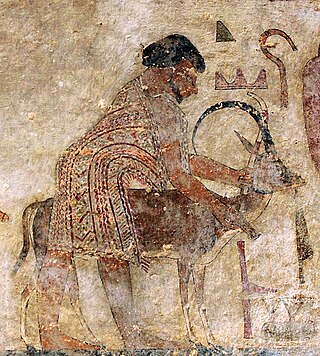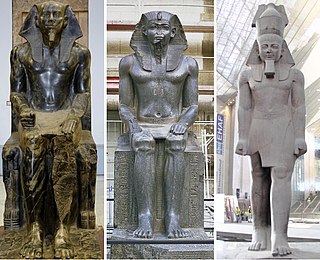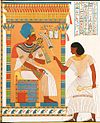
Hathor was a major goddess in ancient Egyptian religion who played a wide variety of roles. As a sky deity, she was the mother or consort of the sky god Horus and the sun god Ra, both of whom were connected with kingship, and thus she was the symbolic mother of their earthly representatives, the pharaohs. She was one of several goddesses who acted as the Eye of Ra, Ra's feminine counterpart, and in this form she had a vengeful aspect that protected him from his enemies. Her beneficent side represented music, dance, joy, love, sexuality, and maternal care, and she acted as the consort of several male deities and the mother of their sons. These two aspects of the goddess exemplified the Egyptian conception of femininity. Hathor crossed boundaries between worlds, helping deceased souls in the transition to the afterlife.

Hyksos is a term which, in modern Egyptology, designates the kings of the Fifteenth Dynasty of Egypt. The seat of power of these kings was the city of Avaris in the Nile delta, from where they ruled over Lower and Middle Egypt up to Cusae.

The Middle Kingdom of Egypt is the period in the history of ancient Egypt following a period of political division known as the First Intermediate Period. The Middle Kingdom lasted from approximately 2040 to 1782 BC, stretching from the reunification of Egypt under the reign of Mentuhotep II in the Eleventh Dynasty to the end of the Twelfth Dynasty. The kings of the Eleventh Dynasty ruled from Thebes and the kings of the Twelfth Dynasty ruled from el-Lisht.

The Second Intermediate Period dates from 1700 to 1550 BC. It marks a period when ancient Egypt was divided into smaller dynasties for a second time, between the end of the Middle Kingdom and the start of the New Kingdom. The Second Intermediate Period generally includes the 13th through to the 17th dynasties. The concept of a "Second Intermediate Period" originated in the twentieth century by Egyptologists from the United Kingdom.

The Third Intermediate Period of ancient Egypt began with the death of Pharaoh Ramesses XI in 1077 BC, which ended the New Kingdom, and was eventually followed by the Late Period. Various points are offered as the beginning for the latter era, though it is most often regarded as dating from the foundation of the Twenty-Sixth Dynasty by Psamtik I in 664 BC, following the departure of the Nubian Kushite rulers of the Twenty-fifth Dynasty after they were driven out by the Assyrians under King Ashurbanipal. The use of the term "Third Intermediate Period", based on the analogy of the well-known First and Second Intermediate Periods, was popular by 1978, when British Egyptologist Kenneth Kitchen used the term for the title of his book on the period. While Kitchen argued that the period was 'far from being chaotic' and hoped that his work would lead to the abolishment of the term, with his own preference being the 'Post-Imperial epoch', his use of the term as a title seems only to have entrenched the use of the term.

The Ipuwer Papyrus is an ancient Egyptian hieratic papyrus made during the Nineteenth Dynasty of Egypt, and now held in the Rijksmuseum van Oudheden in Leiden, Netherlands. It contains the Admonitions of Ipuwer, an incomplete literary work whose original composition is dated no earlier than the late Twelfth Dynasty of Egypt.

The Fifteenth Dynasty was a foreign dynasty of ancient Egypt. It was founded by Salitis, a Hyksos from West Asia whose people had invaded the country and conquered Lower Egypt. The 15th, 16th, and 17th Dynasties of ancient Egypt are often combined under the group title, Second Intermediate Period. The 15th Dynasty dates approximately from 1650 to 1550 BC.

The four sons of Horus were a group of four deities in ancient Egyptian religion who were believed to protect deceased people in the afterlife. Beginning in the First Intermediate Period of Egyptian history, Imsety, Hapy, Duamutef, and Qebehsenuef were especially connected with the four canopic jars that housed the internal organs that were removed from the body of the deceased during the process of mummification. Most commonly, Imsety protected the liver, Hapy the lungs, Duamutef the stomach, and Qebehsenuef the intestines, but this pattern often varied. The canopic jars were given lids that represented the heads of the sons of Horus. Although they were originally portrayed as humans, in the latter part of the New Kingdom, they took on their most distinctive iconography, in which Imsety is portrayed as a human, Hapy as a baboon, Duamutef as a jackal, and Qebehsenuef as a falcon. The four sons were also linked with stars in the sky, with regions of Egypt, and with the cardinal directions.

The Seventeenth Dynasty of Egypt was a dynasty of pharaohs that ruled in Upper Egypt during the late Second Intermediate Period, approximately from 1580 to 1550 BC. Its mainly Theban rulers are contemporary with the Hyksos of the Fifteenth Dynasty and succeed the Sixteenth Dynasty, which was also based in Thebes.

The Thirteenth Dynasty of ancient Egypt is often combined with Dynasties XI, XII and XIV under the group title Middle Kingdom. Some writers separate it from these dynasties and join it to Dynasties XIV through XVII as part of the Second Intermediate Period. Dynasty XIII lasted from approximately 1803 BC until approximately 1649 BC, i.e. for 154 years.

Apepi, Apophis ; regnal names Neb-khepesh-Re, A-qenen-Re and A-user-Re) was a Hyksos ruler of Lower Egypt during the Fifteenth Dynasty and the end of the Second Intermediate Period. According to the Turin Canon of Kings, he reigned over the northern portion of Egypt for forty years during the early half of the 16th century BCE. Although officially only in control of the Lower Kingdom, Apepi in practice dominated the majority of Egypt during the early portion of his reign. He outlived his southern rival, Kamose, but not Ahmose I.

Khaneferre Sobekhotep IV was one of the more powerful Egyptian kings of the 13th Dynasty, who reigned at least eight years. His brothers, Neferhotep I and Sihathor, were his predecessors on the throne, the latter having only ruled as coregent for a few months.

Khaankhre Sobekhotep I was a pharaoh of the Thirteenth Dynasty of Egypt during the Second Intermediate Period.

Seuserenre Khyan (also Khayan or Khian was a Hyksos king of the Fifteenth Dynasty of Egypt, ruling over Lower Egypt in the second half of the 17th century BCE. His royal name Seuserenre translates as "The one whom Re has caused to be strong." Khyan bears the titles of an Egyptian king, but also the title ruler of the foreign land. The later title is the typical designation of the Hyksos rulers.

Ancient Egyptian literature was written in the Egyptian language from ancient Egypt's pharaonic period until the end of Roman domination. It represents the oldest corpus of Egyptian literature. Along with Sumerian literature, it is considered the world's earliest literature.

'Aper-'Anati was a ruler of Lower Egypt during the Second Intermediate Period in the mid-17th century BC. According to Jürgen von Beckerath he was the second king of the 16th Dynasty and a vassal of the Hyksos kings of the 15th Dynasty. This opinion was recently rejected by Kim Ryholt. In his 1997 study of the Second Intermediate Period, Ryholt argues that the kings of the 16th Dynasty ruled an independent Theban realm c. 1650–1580 BC. Consequently, Ryholt sees 'Aper-'Anati as an early Hyksos king of the 15th Dynasty, perhaps its second ruler. This analysis has convinced some Egyptologists, such as Darrell Baker and Janine Bourriau, but not others including Stephen Quirke.

The Abydos Dynasty is hypothesized to have been a short-lived local dynasty ruling over parts of Middle and Upper Egypt during the Second Intermediate Period in Ancient Egypt. The Abydos Dynasty would have been contemporaneous with the Fifteenth and Sixteenth Dynasties, from approximately 1650 to 1600 BC. It would have been based in or around Abydos and its royal necropolis might have been located at the foot of the Mountain of Anubis, a hill resembling a pyramid in the Abydene desert, close to a rock-cut tomb built for pharaoh Senusret III.

Sekhemraneferkhau Wepwawetemsaf was an Egyptian pharaoh during the Second Intermediate Period.

The periodization of ancient Egypt is the use of periodization to organize the 3,000-year history of ancient Egypt. The system of 30 dynasties recorded by third-century BC Greek-speaking Egyptian priest Manetho is still in use today; however, the system of "periods" and "kingdoms" used to group the dynasties is of modern origin. The modern system consists of three "Golden Ages", interspersed between "intermediate periods" and early and late periods.
The royal sealer or royal seal-bearer was an Ancient Egyptian official position and title. The name literally means "sealer of the king of Lower Egypt," but it seems unlikely that the position was ever geographically limited. In the Early Dynastic period and Old Kingdom, it was one of the most important positions in Egypt. The bearer seems to have headed the treasury and had significant symbolic power as an official representative of the Pharaoh. As a "ranking title," it indicated the bearer's pre-eminence in court. In the late Middle Kingdom, it was revived as a ranking title borne by many of the highest officials in the court. This apparently coincided with an increased prominence of seals in the Egyptian administration, as part of a centralisation of the bureaucracy. The title spread more widely in the Second Intermediate period, diluting its power.

















